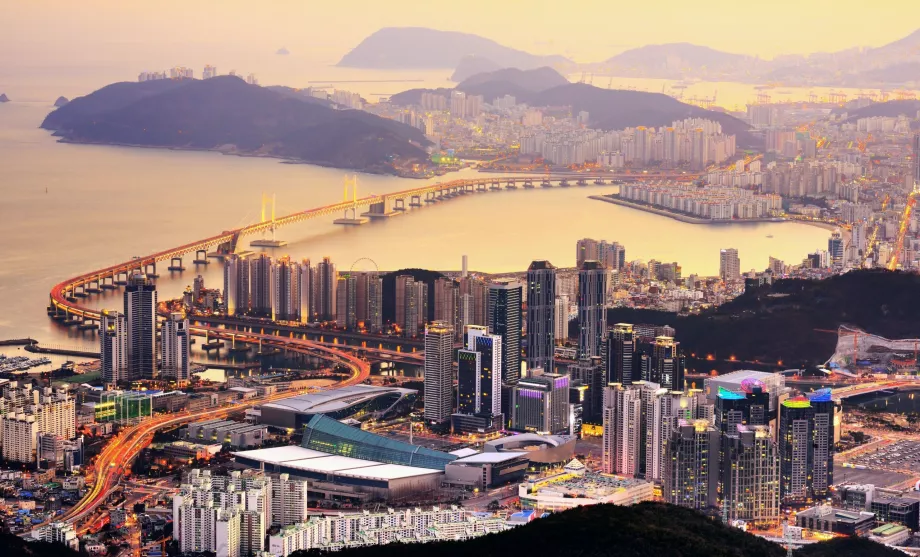Metro in Busan

Busan's metro offers the most efficient way to get around and reach many tourist spots. Where you can't get to by metro, buses will complete the service, which are discussed in the Transport chapter.
Find a hotel near a metro station
How many metro lines are there in Busan? How much do tickets cost and which types of tickets are worthwhile? Find the answers below.
Metro lines in Busan
Busan's rail network includes 4 metro lines, one suburban automatic metro line and one suburban train line. All routes are interconnected by a single fare system and all can be interchanged.
- Line 1 (orange) - the busiest route runs from the southern beaches of Dadaepo via the old centre (Nampo-dong and Jagalchi fish market), Busan Station and the new centre to Nopo Central Bus Station
- Line 2 (green) - connects the tourist district and Haeundae beach with the modern centre, Sasang bus station and continues on to the northern estates and suburbs
- Line 3 (beige) - connects the northern part of the modern centre to the western residential area
- Line 4 (dark blue) - least used by tourists. A short route leads from the northern part of the modern centre to the residential areas in the north-east
- Busan-Gimhae Line - an automated driverless subway line connects to the Orange Line at Sasang Station and runs to Gimhae via Busan Airport
- Donghae Nambu train - the suburban train starts at Bujeon Station in the modern downtown area and goes around the coast to the nearest major city, Ulsan
Busan subway map
The best way to navigate the Pusan metro is to view the map and plan your journey in advance. The winding network is quite confusing at first glance and you'll be unnecessarily delayed if you plan your journey at the station.
An interactive metro map with fare calculations and the fastest route can be found on the official metro website: humetro.busan.kr. However, the map is only available from South Korean IP addresses.
Fares and ticket types
On the Busan metro, you always pay per route travelled. There are also day tickets. A detailed overview of the tickets, which are also valid on buses and in some cases even in other Korean cities, is described in the Transport chapter and can also be found on the official metro website.
Ticket prices
However, we will also summarize the basic variations of ticket prices in this chapter. Fares are calculated according to distance.
- Basic fare (10 stations and less) - 1 300 krw with a transport card (T-money/Cashbee), 1 400 krw for a single ticket
- Basic fare (more than 10 stations) - 1 500 krw with transport card (T-money/Cashbee), 1 600 krw for a single ticket
- Transfer fare for Busan-Gimhae automatic metro - 1 800 krw
- Maximum ticket price on the Donghae Nambu suburban train - 2 500 krw
- All-day ticket (valid on calendar day and on lines 1 to 4 only) - 5 000 krw
To calculate the exact fare and the fastest route, visit: humetro.busan.kr.
Click on the departure station on the map and then immediately click on the arrival station. A pop-up window will show you the fastest route and the exact fare. This website is currently only available from South Korean IP addresses.
How to use the ticket?
If you travel with a T-Money or Cashbee transport card, you don't need to stop at the machines. At these, you only need to top up your credit once in a while, which is gradually deducted from the cards.
Each metro station is equipped with turnstiles that are bi-directional. You always go through the one with the green arrow, put your card to the reader and walk freely.
The same process awaits you when you exit the station.
You do not go through the turnstiles when changing trains.
You can buya single ticket from the machines at each metro station. You can only pay with cash, both coins and banknotes. Select English in the bottom bar of the machine and then select "Destination Selection". You then select the destination station on the touchscreen map and the fare is calculated accordingly. A card will pop up, which you attach to the turnstile when entering and exiting the station.
Timetables and intervals
The metro in Busan runs from about 5:00 am to 11:30 pm (final departures), which means that the train will always be about 30 to 40 minutes late from the centre.
The intervals for each line can be surprisingly long, ranging between 5 and 10 minutes on weekdays and between 7 and 11 minutes on weekends.
Metro stations
At first glance, the metro stations are rather poorly signposted from the outside. Especially in the centre, where the metro runs entirely underground, the entrances to the metro are hardly marked at all. Just look for the entrance to the underpass, which in most cases will also be the entrance to the station.
Then on the outskirts of downtown and outside Busan, most lines are elevated, so you can find the station very quickly.
Toilets can be found at every subway or train station and are always free. The toilets in the Busan metro are clean and modern.
Numbered exits from metro stations are a handy feature. Especially the transfer stations are often a labyrinth. When you get off the train, look for a large map of the station area, either directly on the platform or in the lobby one floor up, which is also in English. On it, all the exits are marked with a number. Choose the one that suits you and just follow the clear signs.
Google maps are also a great help, as the exit numbers are always marked in a yellow rectangle.
At all metro stations, the platform is separated from the tracks and trains by a glass wall with automatic doors. All doors open automatically, no buttons need to be pressed.
Any questions left?
If you have any questions or comments about the article...

